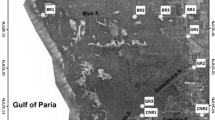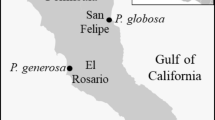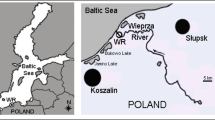Abstract
This study was carried out over a 7-month period at two active clam fishing locations, Ada and Aveglo at the Volta estuary in Ghana, to assess the levels of some heavy metals: Mn, Zn, Fe and Hg in whole soft tissue of Galatea paradoxa and their suitability for human consumption. The clam, Galatea paradoxa (Born 1778) is a commercially important bivalve species exploited mainly for its flesh. In Ghana, it constitutes an important and affordable protein source and is consumed by the riparian communities and beyond the Volta estuary. For each sampling location 30 clams were obtained and grouped into three size classes of 10 individuals, each based on shell lengths. The categorization was as follows: small (25–40 mm), medium (41–55 mm), and large (above 55 mm). The groupings were chosen based on the three dominant size groups in the natural population to give a broad and representative range of metal concentrations in the clams. The concentrations of zinc, iron and manganese were determined using a flame Atomic Absorption Spectrophotometer (AAS) and mercury concentrations were determined using an Atomic Mercury Analyzer. The results were expressed as total concentrations (μg/g dry weight (dw)). There were no significant differences (p>0.05) in Mn, Fe and Zn concentrations among the different size classes except for Hg concentration in clams from Ada, indicating a similar bioavailability of Mn, Fe, Zn at both locations and, possibly, an efficient metabolism to keep the concentrations of Mn, Fe and Zn relatively similar in the tissues of the different clam sizes. Spatial variations in metal concentrations (i.e., Ada small vs. Aveglo small, Ada medium vs. Aveglo medium, and Ada large vs. Aveglo large) were not significant for Mn, Zn and Hg for all the size classes. However, variations in Fe concentration in the large-sized clams was significant (p<0.05).
Heavy metal concentrations in the tissues of the clams were found to be suitable for human consumption based on the WHO Safety Reference Standards for Bivalves and a human health risk assessment methodology.
Similar content being viewed by others
References
Alabaster JS, Lloyd R (1980) Water quality criteria for fish, 2nd edn. Butterworths, London. 546 pp
Amador MK (1997) A review of the Volta Clam, Egeria radiata fishery in the Lower Volta. BSc thesis presented to the Kwame Nkrumah University of Science and Technology, Kumasi Ghana
Amisah S, Adjei-Boateng D, Obirikorang KA, Quagranie KK (2009) Effects of clam size on heavy metal accumulation in whole soft tissues of Galatea paradoxa (Born, 1778) from the Volta estuary, Ghana. Int J Fish Aquac 1(2):14–21
Böhlmark J (2003) Meretrix meretrix as an indicator of heavy metal contamination in Maputo Bay. Thesis Work submitted to the Uppsala University School of Engineering, Program for Aquatic and Environmental Engineering, Department of Earth Sciences, Uppsala University, Sweden
Chiu ST, Lam FS, Tze WL, Chau CW, Ye DY (2000) Trace metals in mussel from mariculture zones, Hong Kong. Chemosphere 41:101–108
Chouba L, Kraiem M, Njimi W, Tissaoui CH, Thompson JR, Flower RJ (2007) Seasonal variation of heavy metals (Cd, Pb and Hg) in sediments and in mullet, Mugil cephalus (Mugilidae), from the Ghar El Melh Lagoon (Tunisia). Waters Bull 4:45–52
Connell D, Lam P, Richardson B, Wu R (1999) Introduction to ecotoxicology. Blackwell, Oxford. p. 71
Cossa D (1989) A review of the use of Mytilus spp as quantitative indicators of cadmium and mercury contamination in coastal waters. Oceanol Acta 12(4):417–432
Cunningham PA, Tripp MR (1975) Factors affecting accumulation and removal of mercury from tissues of the American oyster Crassostrea virginica. Mar Biol 31:311–319
Directorate of Fisheries (2005) Compilation of national fish production, imports, exports and consumption in metric tonnes (2001–2004). Directorate of Fisheries, MoFI Technical Report, Accra, Ghana
El-Shenawy NS (2002) The effect of metal bioaccumulation on glutathione and lipid perodixation as biomarkers of aquatic ecosystem pollution of Ruditapes decussates and Venerupis pullastra from Lake Timsah, Ismailia. Egypt J Zool 39:475–492
Environmental Agency (2008) Using science to create a better place—environmental quality standards for trace metals in the aquatic environment. Science Report-SC030194
Etim LE (1990) Annual variation in proximate composition and condition index of Egeria radiata (Bivalvia : Tellinacea : Donacidae) from Cross River in Nigeria. Niger J Tech Res 2:95–98
Etim L, Akpan ER, Muller P (1991) Temporal trends in heavy metal concentrations in the clam E radiata (Bivalvia: Tellinacea Donacidae) from the Cross River, Nigeria. Rev Hydrobiol Trop 24(4):327–333
Ferreira GA, Machado ALS, Zalmon IR (2004) Temporal and spatial variation on heavy metal concentrations in the bivalve Perna perna (LINNAEUS, 1758) on the Northern Coast of Rio de Janeiro State, Brazil. Braz Arch Biol Technol 47(2):319–327
Food and Agriculture Organization of the United Nations (FAO), FAOSTAT on-line statistical service (2004). Available on-line at http://apps.fao.org. FAO: Rome
Fung CN, Lam JCW, Zheng GJ, Connell DW, Monirith I, Tanabe S, Richardson BJ, Lam PKS (2004) Mussel-based monitoring of trace metal and organic contaminants along the east coast of China using Perna viridis and Mytilus edulis. Environ Pollut 127(2):203–216
Galstoff P (1964) The American oyster Crassostrea virginica. Fish Bull Fish Wildl Serv US 64:1–480
Hotz C, Lowe NM, Araya M, Brown KH (2003) Assessment of the trace element status of individuals and popultions: The example of zinc and copper. Am Soc Nutr Sci 133(5):1563–1560
Järup L (2003) Hazards of metal contamination. Br Med Bull 68:167–182
Jin Q, Liang F, Zhang H, Zhao L, Huan Y, Song D (1999) Application of microwave techniques in analytical chemistry. TrAC Trends Anal Chem 18(7):479–484
Klaassen CD (1996) Casarett & Doull’s toxicology—the basic science of Poisons, 5th edn. McGraw-Hill, New York
Kljaković-Gašpić Z, Ujević I, Zvonarić T, Barić A (2007) Biomonitoring of trace metals (Cu, Cd, Cr, Hg, Pb, Zn) in Mali Ston Bay (eastern Adriatic) using the Mediterranean blue mussel (1998–2005). Acta Adrtiatica 48(1):73–88
Kramer KJM (1994) Biomonitoring of coastal waters and estuaries. CRC Press, Bocca Raton. 327 pp
Kwei EA (1965) The spawning and growth of the Volta oyster, E radiata (clam). Ghana J Sci 5(2):150–160
Latouche YD, Mix MC (1982) The effects of depuration, size and sex on trace metal levels in Bay Mussels. Mar Pollut Bull 13(1):27–29
Lima EFA (1997) Determinação de cádmio, cromo, cobre e zinco em mexilhões Perna perna (LlNNÉ, 1758) do litoral do estado do Rio de Janeiro. Dissertação de Mestrado. Depto de Química, PUC/RJ. 151 pp
Moore JW (1991) Inorganic contaminants of surface water: research and monitoring priorities. Springer, New York
Moses BS (1990) Growth, biomass, mortality, production and potential yield of the West African clam, Egeria radiata (Lamack) (Lamellibranchia, Donacidae) in the Cross River System, Nigeria. Hydrobiologia 196:1–15
Otchere FA (2003) Heavy metals concentrations and burden in the bivalves (Anadara (Senilia) senilis, Crassostrea tulipa and Perna perna) from lagoons in Ghana: model to describe mechanism of accumulation/excretion. Afr J Biotechnol 2(9):280–287
Páez-Osuna P, Frias-Espericueta MG, Osuna-López JI (1995) Trace metal concentrations in relation to season and gonadal maturation in the oyster Crassostrea iridescens. Mar Environ Res 40(1):19–31
Sastre J, Sahuquillo A, Vidal M, Rauret G (2002) Determination of Cd, Cu, Pb and Zn in environmental samples: microwave-assisted total digestion versus aqua regia and nitric acid extraction. Anal Chim Acta 462:59–72
WHO (2000) Safety evaluation of certain food additives and contaminants. WHO food additives series, vol 44. Cambridge University Press, Cambridge
WHO (2001). Environmental health criteria 221, Zinc, pp 360
Zahir F, Rizwi SJ, Haq SK, Khan RH (2005) Low dose mercury toxicity and human health. Environ Toxicol Pharmacol 20:351–360
Author information
Authors and Affiliations
Corresponding author
Rights and permissions
About this article
Cite this article
Obirikorang, K.A., Adjei-Boateng, D. & Amisah, S. Consumption of the Clam, Galatea paradoxa (Born 1778) in Ghana: Human Health Implications with Reference to Heavy Metals. Water Expo. Health 1, 191–201 (2009). https://doi.org/10.1007/s12403-009-0018-3
Received:
Revised:
Accepted:
Published:
Issue Date:
DOI: https://doi.org/10.1007/s12403-009-0018-3




